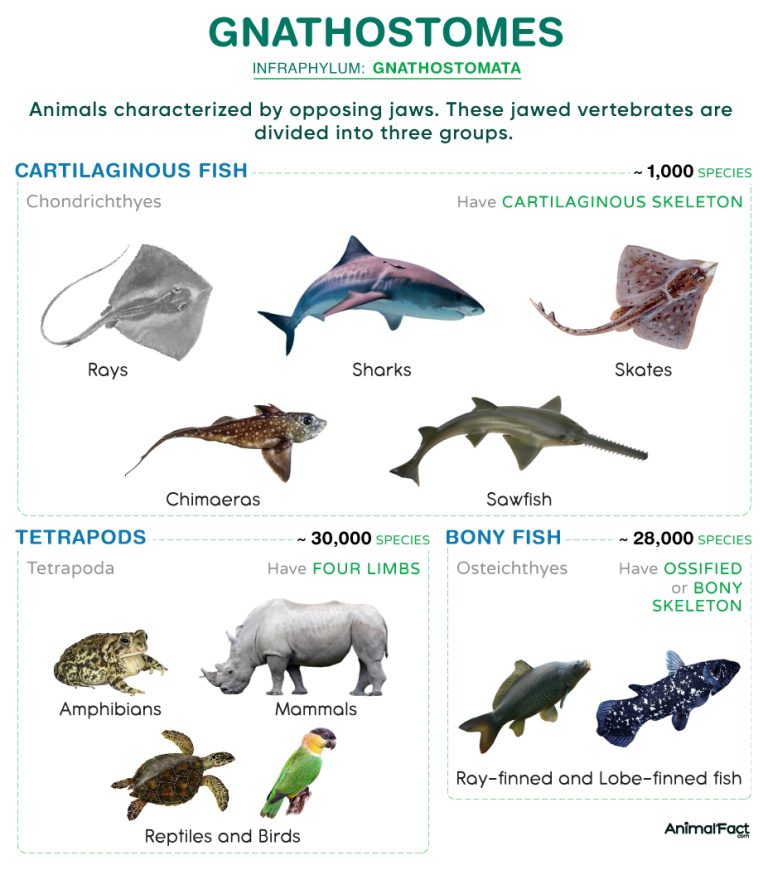


Gnathostomes, also known as jawed vertebrates, belong to the infraphylum Gnathostomata, a name that originated from the Greek words ‘gnathos’ for ‘jaw’ and ‘stoma’ for ‘mouth.’ This group encompasses three extant subgroups: cartilaginous fish (Chondrichthyes), bony fish (Osteichthyes), and tetrapods (Tetrapoda). However, two extinct subgroups, placoderms (Placodermi) and acanthodians (Acanthodii), are also members of this broad group.

With approximately 60,000 species, gnathostomes represent 99% of all living vertebrates.
All gnathostomes, unlike their jawless counterparts of the infraphylum Agnatha, possess a pair of opposing jaws forming the basic framework of the mouth. They also possess paired appendages, such as pectoral and pelvic fins, arms, legs, and wings.
Additionally, they are distinguished by the presence of elastin (a protein that provides elasticity), myelin sheaths that insulate neurons, and a sophisticated immune system that includes lymphoid organs like the spleen and thymus and utilizes V(D)J recombination to generate diverse antigen recognition sites.
Gnathostomata has been traditionally considered an infraphylum with three major extant groups: Chondrichthyes (Cartilaginous fish), Osteichthyes (Bony fish), and Tetrapoda (Tetrapods). Two other groups, Acanthodii (Spiny sharks) and Placodermi (Armored fish), are also placed under this infraphylum but are now extinct.
A group of scientists also considers the class Ostreostraci (not included in the above list), comprising armored jawless fish, a sister group to Gnathostomata.
A group of scientists also considers the class Ostreostraci (not included in the above list), comprising armored jawless fish, a sister group to Gnathostomata.
Jawless fish struggled to survive compared to their jawed counterparts, leading to the extinction of most jawless species during the Triassic Period. However, research on the surviving cyclostomes, which include jawless hagfishes and lampreys, has provided some insight into the significant changes that occurred in the vertebrate skull during the evolution of early jaws.
The ancestors of gnathostomes experienced two rounds of whole genome duplication. The first round occurred before the divergence of jawed and jawless fish, while the second round happened after their split, possibly due to the hybridization of the two lineages.
Recent research indicates that jawed fish evolved from a branch of placoderms. Entelognathus, a 419-million-year-old placoderm fossil, exhibits traits common to both bony and cartilaginous fish. Additionally, primitive bony fishes such as Guiyu oneiros and Psarolepis, which lived simultaneously as Entelognathus, possess features like pelvic girdles, strengthening the ancestral connection between placoderms and jawed fish.
It is believed that the jaws developed from the supporting gill arches, helping these fish push water easily into the mouth. On constantly using the jaw, the gnathostomes also developed the ability to bite.
By the Devonian Period (around 420 to 359 million years ago), these vertebrates had diversified and spread globally, and is thus called the ‘Age of Fishes.’ Late Ordovician (485 to 443 million years ago) microfossils of acanthodian scales mark the first appearance of gnathostomes in the fossil records. Later, Qianodus and Fanjingshania fossils from the early Silurian Period (around 439 million years ago) provided the oldest undisputed evidence of the existence of jawed vertebrates.